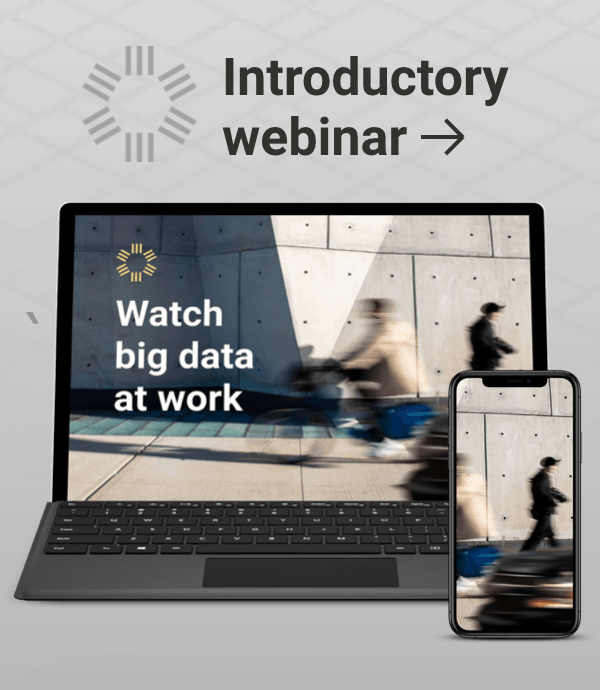
4 Ways Big Data Helps Cities Create Better Transportation Plans

Getting the data you need to make savvy transportation planning decisions can be a lengthy, expensive process if you’re using surveys, license plate counts, or road sensors. These methods also make it difficult to evaluate the performance of a policy or project after implementation.
For example, when planners rely on old or modeled data to design their project, they don’t have a real-world baseline to evaluate current performance after a project is completed. Most road sensors are removed after a few days, so they must be re-installed to collect more data. Surveys can take months or even years to complete. If planners want to make performance-based improvements as they implement policy or infrastructure changes, they often have to start from scratch with data collection. This could create real flaws if your community has seasonal variation based on weather or school – or if your community has new transportation patterns derived from the rise of ride share or urban population growth, for example.
In today’s world, there are much more efficient, up-to-date, and accurate ways to obtain the information you need. Nearly 77% of the US population uses a smartphone, and the data they produce is creating new options for transportation planners. In this article, I’ll share four advantages that Big Data has over conventional data sources for transportation planning.
Why It’s Time To Update Data Collection Methods
Transportation behavior is changing rapidly, and so are other factors that influence planning decisions, such as household characteristics; for example, millennials are more likely to live in high density housing, they’re buying fewer cars and houses than their parents, and they’re delaying parenthood.
For example, according to CNBC survey, 22% of Uber users aged 17 to 64 in the US delayed buying a car because they could use Uber. That’s adds up to as many as four million people opting against cars. However, many of the transportation decisions made today came from household surveys that were taken before ride-share companies such as Uber and Lyft even existed.
This dramatic change in transportation decisions creates a disconnect between projects that were top priorities six years ago and the projects that are need now. We need current data to know how our planning priorities should change to match the behavior and the preferences of people today.
But despite these new challenges, infrastructure and planning budgets are not growing. Communities have to maximize the utility of future spending. That means it’s critical for transportation plans to be based on accurate forecasts and models – and just as it’s critical to measure whether or not policies and infrastructure actually improve conditions as predicted.


The Four Advantages of Big Data
Here are four ways that using Big Data analytics can help:
1. Big Data lets you collect real-world information that is current and up-to-date.
This is particularly true when you compare Big Data to stale household survey data or models. Surveys are valuable in that they can provide much more context about transportation behavior than mobile data alone. However, surveys are difficult to design statistically, the sample sizes are small, and they cannot tell the “full story” of travel behavior objectively because they are respondent-dependent. While models are important for forecasting future conditions, they have to be calibrated with accurate input data to be effective. Using a model that was built with survey data from five years ago is not the best way to model the impact of future transportation decisions.
When you use Big Data, your forecasts are based on real-world location records that reflect current travel patterns. This eliminates the subjectivity inherent to most surveys and yields better modeling results.
2. Big Data is more complete than some traditional methods.
It’s based on comprehensive and measured real-world behavior instead of limiting surveys or sensors. New York City, for example, has a sensor network of 600 cameras installed throughout the city. These sensors can tell city officials a lot about traffic patterns, but the network is primarily used for real-time operations. The network does not provide the origin-destination data required to design and implement effective, long-term transportation plans and strategies, and it doesn’t provide data on the hundreds of other corners not covered by the cameras.
For long-term solutions, it is vital to know where travelers begin and end their trips. It’s also vital to cover travel patterns across an entire busy city or region comprehensively. That’s where Big Data comes in. By supplementing the data generated by stationary sensors with Big Data, we can find solutions to traffic congestion and similarly problematic transportation issues.
3. Big Data lets you collect data more quickly.
You can spend less time gathering data and more time analyzing the complex challenges you uncover with the new information. That’s because Big Data allows you to empirically measure behavior that was previously impossible or too expensive to effectively utilize – and you can access that data much, much faster. For example, with our unique StreetLight InSight® platform, you can run a customized transportation study in just a few mouse clicks right on your computer.
With Big Data, it’s simple to run the same study several times in rapid succession with different parameters. This gives you the flexibility to keep analyzing transportation patterns until you have the information you need. When you use conventional tools, running a transportation study is something that takes weeks, months, or even years to complete at great expense. With StreetLight InSight, it takes less than a day and all you need is a computer and an Internet connection.
4. Big Data helps you understand what projects and policies are most effective.
Big Data allows planners to analyze project performance – even if they didn’t collect the data to begin with. Planners can go “back in time” to see what projects were successful in the past, and whether new initiatives are meeting objectives. This type of critical evaluation leads to deeper trust between decisions makers and constituents. When lessons learned are taken into account, it also enables better cost-benefit analyses for major plans.
When we make decisions using real-world data instead of modeled assumptions, our policy, and infrastructure decisions are far more likely to perform well.
Putting It All Together
Let’s look at why using Big Data to measure project performance can lead to better transportation plans. With Big Data, you can easily and cost-effectively evaluate the impact of decisions – and that leads to better policies and project and prioritization.
By accessing and comparing archival data from different time periods, transportation planners can clearly show the results of their work in terms of:
- Travel time
- Trip speed
- Vehicle-miles travelled
- Route choice
- Impact by demographic group, neighborhood and trip purpose
It’s clear that Big Data presents several key advantages for transportation planning when compared to traditional data collection tools. While surveys and sensors have their merits, they are not enough to measure and diagnose the transportation challenges we face today.